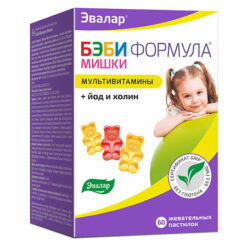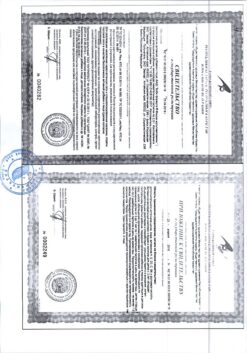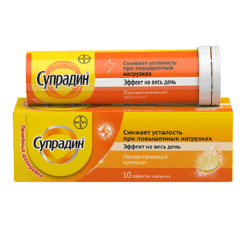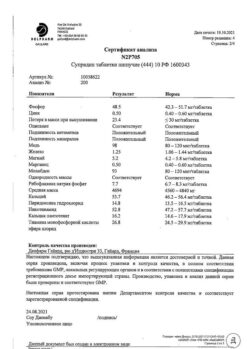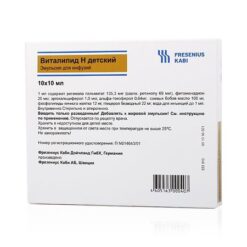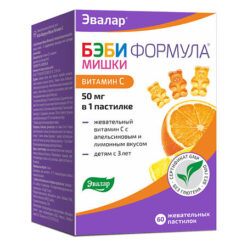No products in the cart.
Bitrigam, 2 ml 10 pcs
€9.28 €8.12
Description
Pharmacotherapeutic group:B vitamins + other drugs.
ATX code: A11DB/N07X.
Pharmacological action
.Pharmacodynamics
A combined multivitamin drug. The action of the drug is determined by the properties of the constituent vitamins. Neurotropic B vitamins have beneficial effects on inflammatory and degenerative diseases of the nervous system and the musculoskeletal system.
Thiamine (Vitamin B 1) – plays a key role in the processes of carbohydrate metabolism, which are critical in the metabolic processes of nervous tissue (involved in the conduction of the nerve impulse) and the Krebs cycle, with subsequent participation in the synthesis of thiamine pyrophosphate (TPP) and adenosine triphosphate (ATP).
Pyridoxine (Vitamin B6) has a vital influence on the metabolism of proteins, carbohydrates and fats, it is essential for normal hematopoiesis and the functioning of the central and peripheral nervous system. It provides synaptic transmission, the processes of inhibition in the central nervous system (CNS), participates in the transport of sphingosine, which is part of the nerve sheath, participates in the synthesis of catecholamines.
The physiological function of both vitamins (B1 and B6) is to potentiate each other’s action, manifesting as a positive effect on the nervous, neuromuscular and cardiovascular systems.
Cyanocobalamin (Vitamin B12) – is involved in the synthesis of nucleotides, is an important factor in growth, hematopoiesis and development of epithelial cells; it is necessary for the metabolism of folic acid and myelin synthesis.
Lidocaine has an anesthetic effect at the injection site, dilates blood vessels and promotes the absorption of vitamins. The local anesthetic effect of lidocaine is due to the blockade of potential-dependent sodium channels, which prevents the generation of impulses along the nerve fibers.
Pharmacokinetics
Thiamine
. After intramuscular administration, thiamine is rapidly absorbed from the injection site and enters the blood (484 ng/mL after 15 min on the first day of the 50 mg dose) and is unevenly distributed in the body, with its content in white blood cells 15%, red blood cells 75% and plasma 10%. Because of the lack of significant stores of the vitamin in the body, it must be administered daily. Thiamine penetrates the blood-brain and placental barriers and is found in breast milk. Thiamine is excreted in the urine in the alpha phase after 0.15 hours, in the beta phase after 1 hour, and in the terminal phase within 2 days. The main metabolites are: thiaminicarboxylic acid, pyramine and some unknown metabolites. Of all the vitamins, thiamine is retained in the body in the smallest amounts. The adult body contains about 30 mg of thiamine as 80% thiamine pyrophosphate, 10% thiamine triphosphate and the rest as thiamine monophosphate.
Pyridoxine
. After intramuscular injection, pyridoxine is rapidly absorbed into the bloodstream and distributed in the body, acting as a coenzyme after phosphorylation of the CH2ON group in the 5th position. About 80% of the vitamin is bound to plasma proteins. Pyridoxine is distributed throughout the body, passes through the placenta, and is found in breast milk. It accumulates in the liver and is oxidized to 4-pyridoxylic acid, which is excreted by the kidneys in 2-5 hours after absorption maximum.
The human body contains 40-150 mg of vitamin B6 and its daily elimination rate is about 1.7-3.6 mg with a replenishment rate of 2.2-2.4%.
Cyanocobalamin
Cyanocobalamin binds to transcobalamin I and II after intramuscular administration and is transported to various body tissues. The maximum concentration after intramuscular administration is reached after 1 hour. Binding with blood plasma proteins is 90%. It penetrates through the placental barrier and is detected in breast milk. It is metabolized mainly in the liver to form adenosylcobalamin, which is the active form of cyanocobalamin. It is deposited in the liver, passes into the intestine with the bile, and is absorbed back into the blood (enterohepatic circulation phenomenon). The elimination half-life is long; it is eliminated mainly by the kidneys (7-10%) and through the intestines (50%). With decreased renal function excreted 0-7% and through the intestine – 70-100%.
Lidocaine
In intramuscular administration, the maximum plasma concentration of lidocaine is observed 5-15 minutes after injection. Depending on the dose, about 60-80% of lidocaine is bound to plasma proteins. It is rapidly distributed (within 6-9 minutes) in organs and tissues with good perfusion, including heart, lung, liver, kidney and then in muscle and fat tissues. It penetrates through the blood-brain barrier and the placental barrier, is detected in breast milk (up to 40% of the concentration in maternal blood plasma). It is metabolized in the liver with the participation of microsomal enzymes to form active metabolites – monoethylglycinxylide and glycinxylidide, which have half-life of 2 and 10 hours, respectively. The intensity of metabolism is reduced in liver disease. It is excreted mainly as metabolites by kidneys and up to 10% unchanged.
Indications
Indications
In the complex therapy:
Composition
Composition
1 ml of solution for intramuscular injection contains:
The active ingredients:
thiamine hydrochloride – 50 mg,
pyridoxine hydrochloride – 50 mg,
Cyanocobalamin – 0.5 mg,
Lidocaine hydrochloride – 10 mg;
Excipients: benzyl alcohol – 20 mg, sodium polyphosphate – 10 mg, potassium hexacyanoferrate – 0.1 mg, sodium hydroxide – 6 mg, water for injection to 1 ml.
How to take, the dosage
How to take, the dosage
Injections are performed deeply intramuscularly (see section “Special indications”).
In cases of severe pain syndrome in order to quickly achieve high blood levels of the drug it is reasonable to start treatment with intramuscular injection (deep) of 2 ml daily for 5-10 days with subsequent transition either to oral administration or to less frequent injections (2-3 times a week for 2-3 weeks) with possible continuation of therapy by oral dosage form.
Therapies need to be monitored weekly by a physician. The duration of therapy is determined by the doctor individually, depending on the severity of the symptoms.
The transition to therapy with oral dosage form is recommended as soon as possible.
Interaction
Interaction
B vitamins
Vitamin B1 (thiamine) breaks down completely in solutions containing sulfites. And as a consequence, the breakdown products of thiamine inactivate the actions of other vitamins. Thiamine is incompatible with oxidizing and reducing compounds, including: iodides, carbonates, acetates, tannic acid, iron-ammonium citrate, as well as phenobarbital, riboflavin, benzylpenicillin, dextrose, metabisulfite. Copper accelerates the degradation of thiamine; in addition, thiamine loses its effectiveness with increasing pH values (more than Z).
Therapeutic doses of vitamin B6 (pyridoxine) weaken the effect of levodopa (its anti-Parkinsonian effect is reduced) when used simultaneously. Interaction with cycloserine, penicillamine, isoniazid is also observed.
Vitamin B12 (cyanocobalamin) is incompatible with ascorbic acid and salts of heavy metals.
Lidocaine
In parenteral use of lidocaine, if additional norepinephrine and epinephrine are used, an increase in adverse cardiac reactions is possible. Interaction with sulfonamides has also been observed. In case of overdose of local anesthetic agents, epinephrine and norepinephrine should not be used additionally.
Special Instructions
Special Instructions
The drug should only be administered intramuscularly, avoiding vascular ingestion. If accidentally administered intravenously, the patient should be monitored by a physician or hospitalized, depending on the severity of symptoms.
The drug may cause neuropathies if used for more than 6 months.
Influence on driving and operating ability
There is no information about the effect of the drug on driving ability as well as on performance of potentially hazardous activities requiring increased concentration and quick psychomotor reactions.
But caution is recommended, because of the possibility of adverse reactions of the drug.
Synopsis
Synopsis
Contraindications
Contraindications
Overdose
Overdose
Pregnancy use
Pregnancy use
Additional information
| Shelf life | 2 years. Do not use after the expiration date. |
|---|---|
| Conditions of storage | Store at 2 to 8 oC in a secondary package (cardboard box). Keep out of reach of children. |
| Manufacturer | Biok Kursk Biofabrika FKP, Russia |
| Medication form | solution |
| Brand | Biok Kursk Biofabrika FKP |
Related products
Buy Bitrigam, 2 ml 10 pcs with delivery to USA, UK, Europe and over 120 other countries.


